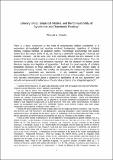Files in this item
Literary Unity, Empirical Models, and the Compatibility of Synchronic and Diachronic Reading
Item metadata
| dc.contributor.author | Tooman, William Arthur | |
| dc.contributor.editor | Tooman, William | |
| dc.contributor.editor | Barter, Penelope | |
| dc.date.accessioned | 2019-04-06T23:39:52Z | |
| dc.date.available | 2019-04-06T23:39:52Z | |
| dc.date.issued | 2017-04 | |
| dc.identifier | 235505424 | |
| dc.identifier | aaabf8fd-d2f4-4193-b8cb-ae4599c7e212 | |
| dc.identifier.citation | Tooman , W A 2017 , Literary Unity, Empirical Models, and the Compatibility of Synchronic and Diachronic Reading . in W Tooman & P Barter (eds) , Ezekiel : Current Debates and Future Directions . Forschungen zum Alten Testament 1 , vol. 112 , Mohr Siebeck . | en |
| dc.identifier.isbn | 978-3-16-153089-0 | |
| dc.identifier.isbn | 978-3-16-154714-0 | |
| dc.identifier.other | ORCID: /0000-0001-6989-8267/work/60887279 | |
| dc.identifier.uri | https://hdl.handle.net/10023/17473 | |
| dc.description.abstract | There is a basic irresolution at the heart of contemporary biblical scholarship. It is everywhere acknowledged and nowhere resolved. Interpreters, regardless of scholarly training, religious heritage, or academic context, increasingly acknowledge that ancient Jewish texts are unique works of art, each bearing a distinctive ideological, rhetorical, and aesthetic character. At the same time, it is commonly allowed that this character is the product of (at least some) creative processes of composition and editorial shaping. Thus, the conviction is widely held and commonly expressed that the character of ancient Jewish literature requires an integration of approaches. And yet, the great majority of scholarly production continues to focus attention on one aspect or the other: literary shape or compositional history. Indeed, few scholars are discussing the relationship between these approaches – synchronic and diachronic – in any sustained way. Despite wide acknowledgement that both are somehow essential to the task of text-analysis, there has been only sporadic conversation about a cooperative application of the two approaches and virtually no hermeneutical reflection on the attendant problems of an integrated approach. This essay argues that both approaches make (possible) claims about how the sequence of graphemes presented to us came about. Thus, the relationship of synchronic to diachronic approaches cannot be reduced to different aims or different text-analytic goals. They are not different hats that the critic can change at will, depending on the task of the day. It is further argued that synchronic and diachronic scholarship share similar standards of what constitutes textual unity and both assume the normalcy of such unity. However, empirical evidence reveals limitations in both approaches that are particularly manifest when practitioners of either approach adopt the assumption of unity too rigidly. | |
| dc.format.extent | 340653 | |
| dc.language.iso | eng | |
| dc.publisher | Mohr Siebeck | |
| dc.relation.ispartof | Ezekiel | en |
| dc.relation.ispartofseries | Forschungen zum Alten Testament 1 | en |
| dc.subject | Synchronic | en |
| dc.subject | Diachronic | en |
| dc.subject | Empirical model | en |
| dc.subject | Unity | en |
| dc.subject | Literary reading | en |
| dc.subject | Historical-criticism | en |
| dc.subject | Redaction criticism | en |
| dc.subject | Ezekiel | en |
| dc.subject | Ezekiel 36 | en |
| dc.subject | BS The Bible | en |
| dc.subject.lcc | BS | en |
| dc.title | Literary Unity, Empirical Models, and the Compatibility of Synchronic and Diachronic Reading | en |
| dc.type | Book item | en |
| dc.contributor.sponsor | ANON | en |
| dc.contributor.institution | University of St Andrews. School of Divinity | en |
| dc.date.embargoedUntil | 2019-04-07 | |
| dc.identifier.url | https://www.mohr.de/en/book/ezekiel-9783161547140 | en |
| dc.identifier.grantnumber | en |
This item appears in the following Collection(s)
Items in the St Andrews Research Repository are protected by copyright, with all rights reserved, unless otherwise indicated.

